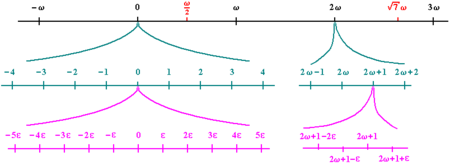This article needs additional citations for verification. (July 2023) |

In mathematics, hyperreal numbers are an extension of the real numbers to include certain classes of infinite and infinitesimal numbers.[1] A hyperreal number is said to be finite if, and only if, for some integer .[1][2] is said to be infinitesimal if, and only if, for all positive integers .[1][2] The term "hyper-real" was introduced by Edwin Hewitt in 1948.[3]
The hyperreal numbers satisfy the transfer principle, a rigorous version of Leibniz's heuristic law of continuity. The transfer principle states that true first-order statements about R are also valid in *R.[4] For example, the commutative law of addition, x + y = y + x, holds for the hyperreals just as it does for the reals; since R is a real closed field, so is *R. Since for all integers n, one also has for all hyperintegers . The transfer principle for ultrapowers is a consequence of Łoś's theorem of 1955.
Concerns about the soundness of arguments involving infinitesimals date back to ancient Greek mathematics, with Archimedes replacing such proofs with ones using other techniques such as the method of exhaustion.[5] In the 1960s, Abraham Robinson proved that the hyperreals were logically consistent if and only if the reals were. This put to rest the fear that any proof involving infinitesimals might be unsound, provided that they were manipulated according to the logical rules that Robinson delineated.
The application of hyperreal numbers and in particular the transfer principle to problems of analysis is called nonstandard analysis. One immediate application is the definition of the basic concepts of analysis such as the derivative and integral in a direct fashion, without passing via logical complications of multiple quantifiers. Thus, the derivative of f(x) becomes for an infinitesimal , where st(⋅) denotes the standard part function, which "rounds off" each finite hyperreal to the nearest real. Similarly, the integral is defined as the standard part of a suitable infinite sum.
- ^ a b c Weisstein, Eric W. "Hyperreal Number". mathworld.wolfram.com. Retrieved 2024-03-20.
- ^ a b Robinson, Abraham (1979). Selected papers of Abraham Robinson. 2: Nonstandard analysis and philosophy. New Haven: Yale Univ. Press. p. 67. ISBN 978-0-300-02072-4.
- ^ Hewitt (1948), p. 74, as reported in Keisler (1994)
- ^ Dauben, Joseph Warren (1995). Abraham Robinson: the creation of nonstandard analysis: a personal and mathematical odyssey. Princeton legacy library. Princeton, New Jersey: Princeton University Press. p. 474. ISBN 978-0-691-03745-5.
- ^ Ball, p. 31








